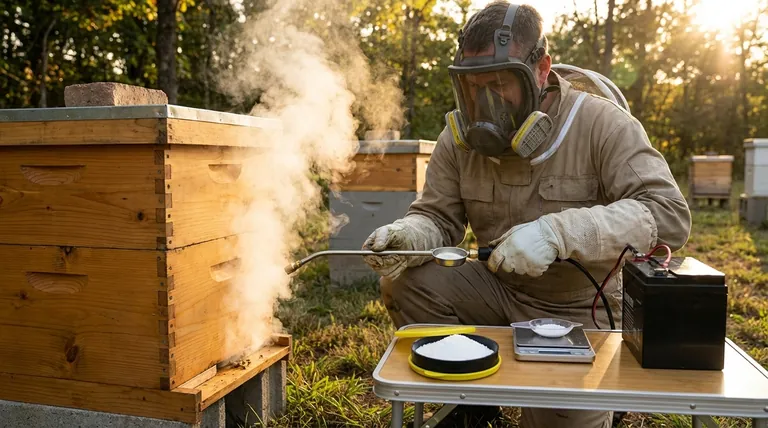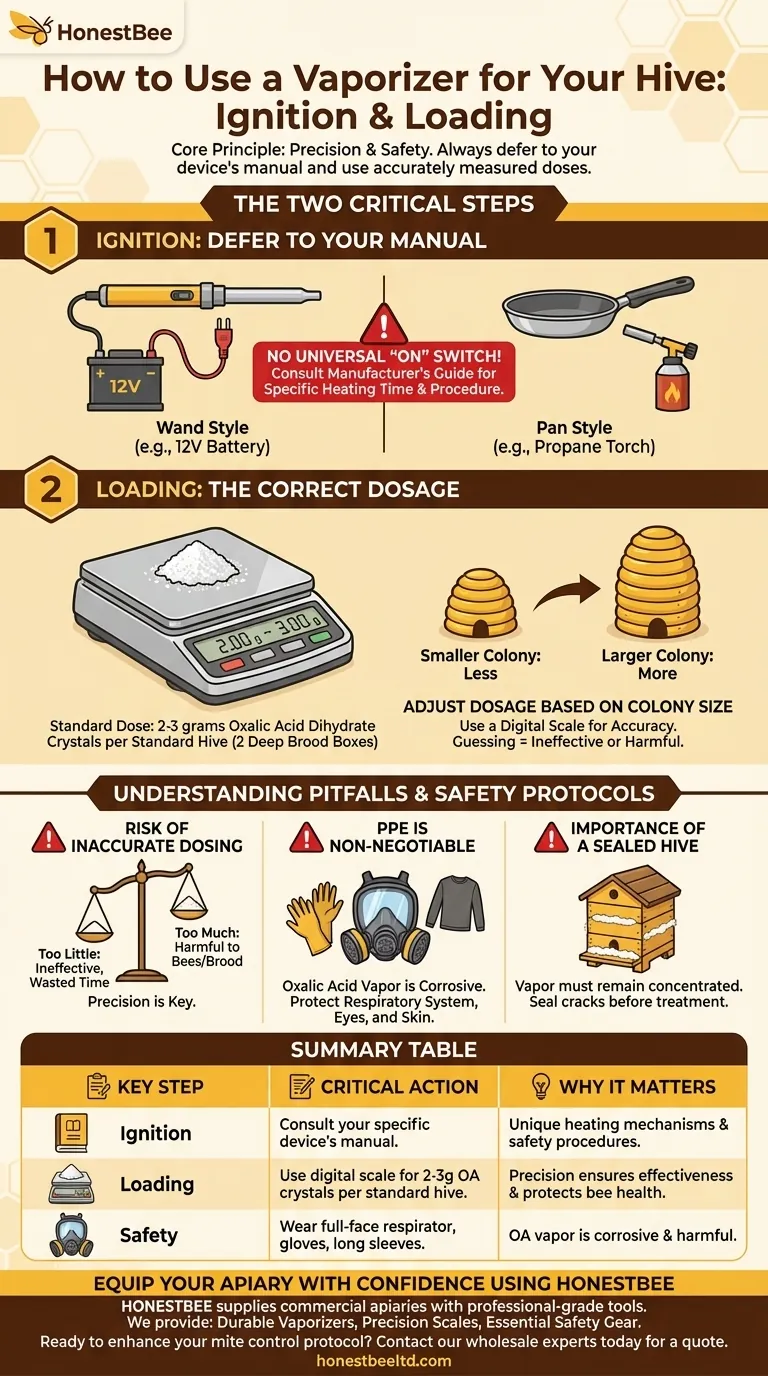To properly use a vaporizer for your hive, you must first ignite it according to the specific instructions provided by the manufacturer, as different models have unique heating mechanisms. Once heated, it is loaded with a precise amount of oxalic acid, typically between 2 and 3 grams per standard hive, to ensure an effective and safe treatment.
The core principle of using an oxalic acid vaporizer is not about a single universal method, but about precision and safety. Always defer to your device's manual for ignition and use an accurately measured dose to protect your bees and yourself.

The Two Critical Steps: Ignition and Loading
Successfully treating a beehive with an oxalic acid vaporizer hinges on performing two steps correctly. Each requires careful attention to detail to ensure the treatment is effective and all safety protocols are met.
Step 1: Ignition - Defer to Your Manual
There is no single "on" switch for all vaporizers. The market includes various designs, each with a different method for reaching the correct sublimation temperature.
Common ignition methods include connecting a wand-style device to a 12V battery or heating a pan-style vaporizer with a propane torch.
Because these methods are so different, consulting your manufacturer's guide is the only safe way to proceed. This document will specify the heating time and correct operational procedure.
Step 2: Loading the Correct Dosage
The standard dose is generally 2 to 3 grams of oxalic acid dihydrate crystals per hive. This amount is typically intended for a standard Langstroth hive consisting of two deep brood boxes.
It is crucial to adjust the dosage based on the size of your colony. A smaller nucleus colony will require significantly less, while a towering hive may require more.
Always use a digital scale that measures in grams to ensure accuracy. Guessing the amount can lead to an ineffective treatment or, conversely, harm to your bees.
Understanding the Pitfalls and Safety Protocols
Applying oxalic acid is a chemical treatment, and overlooking safety or precision can have serious consequences. Understanding the risks is as important as knowing the procedure.
The Risk of Inaccurate Dosing
Using too little oxalic acid will fail to eliminate a sufficient number of varroa mites, rendering the treatment ineffective and wasting your time.
Conversely, using too much can be harmful to your bees, particularly the brood, and does not increase the treatment's effectiveness against mites. Precision is key.
Personal Protective Equipment (PPE) is Non-Negotiable
Oxalic acid vapor is corrosive and highly damaging to the respiratory system, eyes, and skin.
You must wear, at a minimum: a full-face respirator with acid gas cartridges, chemical-resistant gloves, and long sleeves. Do not perform this procedure without the correct PPE.
The Importance of a Sealed Hive
For the treatment to be effective, the vapor must remain concentrated inside the hive for a set period.
Before beginning, seal any large cracks or entrances with foam or cloth. This ensures the vapor reaches all corners of the hive and effectively treats the colony.
Applying This to Your Beekeeping Practice
The goal of vaporization is a safe, effective mite treatment. How you approach the process should align with this primary objective.
- If your primary focus is safety and effectiveness: Always read your vaporizer's manual before the first use and wear the correct PPE, especially an acid-gas-rated respirator.
- If your primary focus is accurate hive treatment: Use a digital scale to measure the precise dose of oxalic acid crystals based on your specific hive's size and configuration.
By mastering these fundamentals of ignition and loading, you can perform varroa mite treatments confidently and effectively.
Summary Table:
| Key Step | Critical Action | Why It Matters |
|---|---|---|
| Ignition | Consult your specific device's manual. | Different models (wand, pan) have unique heating mechanisms and safety procedures. |
| Loading | Use a digital scale to measure 2-3 grams of OA crystals per standard hive. | Precision ensures effectiveness against mites and protects bee health. |
| Safety | Wear a full-face respirator with acid gas cartridges, gloves, and long sleeves. | OA vapor is corrosive and harmful to lungs, eyes, and skin. |
Equip Your Apiary with Confidence Using HONESTBEE
Mastering varroa mite treatment requires not just knowledge but also reliable, high-quality equipment. At HONESTBEE, we supply commercial apiaries and beekeeping equipment distributors with the professional-grade tools needed for safe and effective hive management.
We can provide you with:
- Durable Vaporizers: Built for repeated, commercial-use cycles.
- Precision Scales: Essential for accurate oxalic acid dosing.
- Essential Safety Gear: Including respirators to protect your team.
Ready to enhance your mite control protocol with equipment you can trust? Contact our wholesale experts today to discuss your apiary's needs and get a quote.
Visual Guide

Related Products
- Adjustable Formic and Acetic Acid Dispenser for Bee Mite Treatment
- Economy Small Scale Honey Dryer Dehumidifier Thickening Machine
- High Quality Honey Dehumidifier Dryer Thickening Machine for Beekeeping
- Honey Concentrating Vacuum Heating Thickening Machine Dehumidifier for Honey
- 8-Frame Electric Self-Reversing Honey Extractor Spinner for Commercial Honey Extraction Equipment
People Also Ask
- What does Chewed Down Brood (CDB) indicate in bee colonies? A Sign of Varroa Mite Infestation
- What should be done after treating a colony for varroa mites? A Step-by-Step Guide to Verifying Success
- What is the focus of hive management during summer? Maximize Your Honey Harvest with Expert Tips
- What are the symptoms of Varroa Mite Syndrome (VMS)? Recognizing the Signs of Colony Collapse
- What should beekeepers do to manage varroa mites effectively? Adopt a Proactive Monitoring Strategy



















